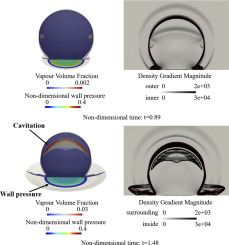Advances in Colloid and Interface Science ( IF 15.6 ) Pub Date : 2018-08-25 , DOI: 10.1016/j.cis.2018.08.004 Nikolaos Kyriazis , Phoevos Koukouvinis , Manolis Gavaises

|
The impact of liquid droplets on solid surfaces at conditions inducing cavitation inside their volume has rarely been addressed in the literature. A review is conducted on relevant studies, aiming to highlight the differences from non-cavitating impact cases. Focus is placed on the numerical models suitable for the simulation of droplet impact at such conditions. Further insight is given from the development of a purpose-built compressible two-phase flow solver that incorporates a phase-change model suitable for cavitation formation and collapse; thermodynamic closure is based on a barotropic Equation of State (EoS) representing the density and speed of sound of the co-existing liquid, gas and vapour phases as well as liquid-vapour mixture. To overcome the known problem of spurious oscillations occurring at the phase boundaries due to the rapid change in the acoustic impedance, a new hybrid numerical flux discretization scheme is proposed, based on approximate Riemann solvers; this is found to offer numerical stability and has allowed for simulations of cavitation formation during drop impact to be presented for the first time. Following a thorough justification of the validity of the model assumptions adopted for the cases of interest, numerical simulations are firstly compared against the Riemann problem, for which the exact solution has been derived for two materials with the same velocity and pressure fields. The model is validated against the single experimental data set available in the literature for a 2-D planar drop impact case. The results are found in good agreement against these data that depict the evolution of both the shock wave generated upon impact and the rarefaction waves, which are also captured reasonably well. Moreover, the location of cavitation formation inside the drop and the areas of possible erosion sites that may develop on the solid surface, are also well captured by the model. Following model validation, numerical experiments have examined the effect of impact conditions on the process, utilizing both planar and 2-D axisymmetric simulations. It is found that the absence of air between the drop and the wall at the initial configuration can generate cavitation regimes closer to the wall surface, which significantly increase the pressures induced on the solid wall surface, even for much lower impact velocities. A summary highlighting the open questions still remaining on the subject is given at the end.
中文翻译:

模拟掉落在固体表面上的撞击过程中的气穴现象
文献中很少涉及液滴在引起其内部空化的条件下对固体表面的影响。对相关研究进行了审查,旨在强调与非空袭影响案例的区别。重点放在适合于在这种条件下模拟液滴撞击的数值模型上。通过开发专用的可压缩两相流求解器,可以得到更多的见解,该求解器结合了适用于空化形成和坍塌的相变模型。热力学封闭基于正压状态方程(EoS),该方程表示共存的液相,气相和气相以及液蒸气混合物的密度和声速。为了克服由于声阻抗的快速变化而在相边界处出现寄生振荡的已知问题,提出了一种基于近似黎曼求解器的新型混合数值通量离散化方案。发现这提供了数值稳定性,并首次模拟了跌落冲击过程中的气穴形成。在针对感兴趣的情况所采用的模型假设的有效性进行了充分的论证之后,首先将数值模拟与Riemann问题进行了比较,针对该问题,已经针对具有相同速度和压力场的两种材料得出了精确的解。该模型针对文献中针对二维平面跌落冲击的情况下可用的单个实验数据集进行了验证。发现的结果与这些数据完全吻合,这些数据描述了撞击产生的冲击波和稀疏波的演变,它们也被很好地捕获。此外,该模型还很好地捕获了液滴内部空化形成的位置以及可能在固体表面上形成的可能的腐蚀部位的区域。在模型验证之后,数值实验利用平面和二维轴对称仿真检查了冲击条件对过程的影响。已经发现,在初始构型下,液滴和壁之间不存在空气会产生更靠近壁表面的气蚀状态,即使对于较低的冲击速度,其也会显着增加在固体壁表面上引起的压力。


























 京公网安备 11010802027423号
京公网安备 11010802027423号